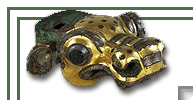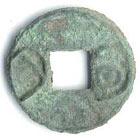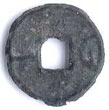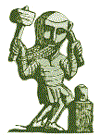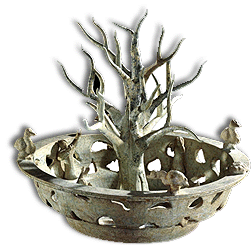ZHOU DYNASTY, 1122 to 255 BC
"Zhou Dynasty", the usual name for this period, is a poor choice. When the Zhou conquered the Shang in about 1122 BC, they were very powerful, but by 6th and 7th centuries BC, Zhou was a figurehead royal seat with no power and little significance with respect to coinage. Real power was split between a number of feudal dynasties.
Some dynasties appear to have retained minting authority in their central governments, but most appear to have relegated it to the local level. This makes classification by dynasty difficult as we do not always know who the local authorities were affiliated with. We hope to one day organize the coins into their appropriate dynasties and minting authorities, but for the moment this is not possible and we must continue using the heading of "Zhou", providing only a general outline of the coinage until more information becomes available.
For more information on the coinage of the Zhou Dynasty, please check our Reference Guide.

CH'IN DYNASTY, 255 to 206 BC
Ch'in existed as a feudal state under the Zhou since before 1000 BC, casting coins from about 400 BC.
Traditionally we refer to the Ch'in Dynasty as beginning in 255 BC when the Ch'in conquered the Zhou. Some date it to 221 BC when they finished unifying China (note this unified China was much smaller than the China we know today), but the Ch'in themselves probably would have used a date of about 325 BC when Duke Hsuan Wen adopted the title of Emperor after defeating the state of Wen and withdrew Ch'in allegiance to the Zhou.

KNOWN RULERS OF CH'IN
Duke Hsiao, 361 to 338 BC
Duke Hsuan Wen, 337 to 310 BC
known as Emperor Hsuan Wen after 325 BC
Emperor Wu, 310 to 307 BC
|
Emperor Chao Siang, 306 to 251 BC
Emperor Cheng, 250 to 210 BC
known as Emperor Ch'in Shih Huang after 221 BC
Emperor Ti, 221 to 210 BC |
Emperor Eri Shih Huang Tii, 209 to 207 BC |
It is commonly accepted that in 221 BC, at the time of the unification, Ch'in introduced the Pan (pronounced "Ban") Liang coinage, discontinuing knife and spade coinage. This is by no means certain and we find it difficult to accept, believing the coinage of this period is more complex and knife and spade coinage was phased out gradually. There is the possibility that some Square-Foot Spades and early Square-Holed Round Coins were cast under the Ch'in, but we also believe the earliest Pan Liang were cast before 221 BC.
For more information on the coinage of the Ch'in Dynasty, please check our Reference Guide.

WESTERN HAN DYNASTY, 206 BC to AD 25
The House of Han ruled all China for almost four hundred years. The traditional starting date for Han rule is 206 BC. They were first known as the Western Han, ruling from Ch'ang-an in Shansi Province. Broken only by the brief interregnum of Wang Mang's Hsin dynasty of AD 9 to 22, the Western Han lasted until AD 25 when the capital was moved to Lo-yang (in Honan Province) and the name was changed to Eastern Han.

EMPERORS OF WESTERN HAN
Rebel Liu-peng, BC 206 to 203
Kao Tsu, BC 202 t0 196
formerly Rebel Liu-peng
Hui Ti, BC 195 to 187
with Lu Hou as regent
Empress Kao, BC 187 to 180
also known as Lu Hou
Wen Ti, BC 179 to 157
King Ti, BC 156 to 141
Wu Ti, BC 140 to 87
Chao Ti, BC 86 to 74 |
Hsuan Ti, BC 73 to 49
Yuan Ti, BC 48 to 33
Ch'eng Ti, BC 32 to 5
Ngai Ti, BC 6 to 1
P'ing Ti, AD 1 to 6
Wang Mang as regent
Ju Tze Ying, AD 7 to 8
Wang Mang as acting Emperor
Rebel Wang Mang, AD 9 to 22
Kuang Wu Ti, AD 22 to 25
also know as Liu* |
*Liu was the last Emperor of Western Han
and the first emperor of Eastern Han. |
For more information on the coinage of the Western Han Dynasty, please check our Reference Guide.

HSIN DYNASTY, AD 7 to 23
Interregnum of Wang Mang
The interregnum of Wang Mang was a very interesting time in Chinese history, but remember the old curse, "May you live in interesting times".
The exact dates and events that led Wang Mang to power differ a little between references, but for the time being we are using mostly those given by Robert Tye in his essay WANG MANG (paperback, 20 pages), but in a few cases, where noted, other dates may be used. If you are interested in learning more about this period and would like to read his essay, let us know and we will see if it is still available from him.
About 47 BC, Mang was born into the most powerful family in China, a family that effectively ruled through a series of puppet Han emperors. He held a series of high governmental posts before becoming Minister of War in 7 BC, but fell from favor and retired two years later.
Robert Tye records that in AD 3 Mang became father-in-law to the Emperor and, in AD 6, was appointed regent to the child Emperor P'ing Ti. This differs somewhat from the information recorded by Michael Mitchiner (in Oriental Coins and their Values, The Ancient & Classical World) who says Wang became regent to P'ing Ti in AD 1 but replaced him with Ju Tze Yung in AD 7 at which time Wang gave himself the office of Acting Emperor.
Both sources agree that in AD 9 (January 10 according to Tye) Wang declared himself Emperor, establishing his "Hsin" (new) Dynasty.
The China of Wang Mang's day was one of extreme wealth and yet extreme poverty: a very few owned almost everything while the vast majority of people just barely survived. Wang set up a system very much like modern communism, and through a series of monetary and economic reforms confiscated the wealth of the elite, redistributing part of it among the common people. His first two coinage reforms, along with the nationalization of land in his economic reforms, succeeded in confiscating the wealth of the elite, transferring it to the state treasuries where it remained until Mang's death when 150 tons of gold were found to be still in storage.
He tried (with only partial success) to abolish slavery, he nationalized land and distributed it in plots to those who wished to work it, and he reformed the tax system to make it fair to all. He brought in a system to regulate prices, and his third coinage reform was intended to facilitate trade. None of this worked the way he intended and his fourth and fifth reforms seem to have been an attempt to undo the damage.
In the end, he created a nightmare of political and economic upheaval that resulted in famines, anarchy and rebellions among displaced people. The last years of his reign were a period of chaos during which an estimated twenty-five million people died, about half China's population. It must have been a very interesting time, indeed!
As with many aspects of the early years of Wang Mang, there is dispute over his reign titles. So far we have found the following information, but it may not be fully accurate:
CHE-SHE **, AD 7 to 8, As acting Emperor of Han
HUANG-SHIH-CHU *, or SHE-KIEN-KWA **, AD 9 to 14, As Emperor of Hsin
T'IEN-FENG, AD 14 to 22, As Emperor of Hsin
*Tye **Mitchiner
For more information on the coinage of Wang Mang, please check our Reference Guide.

EASTERN HAN DYNASTY, AD 25 to 221
In AD 22, a man connected to the House of Han and known as Liu, rebelled against and captured Wang Mang, re-establishing the Western Han Dynasty. As the last Emperor of the Western Han, Liu moved the capital to Lo-yang in Honan Province, at which time he also became the first Emperor of the Eastern Han and adopted the name Kuang Wu Ti.

EMPERORS OF EASTERN HAN
Kuang Wu Ti, AD 25 to 57
also know as Liu*
Ming Ti, AD 58 to 75
Chang Ti, AD 76 to 88
Ho Ti, AD 89 to 105
Chang Ti, AD 106 to 107
Ngan Ti, AD 107 to 124
Chao Ti, AD 125 to 126
Chuen Ti, AD 126 to 144
Ch'ang Ti, AD 145 to 146 |
Che Ti, AD 146 to 147
Huan Ti, AD 147 to 167
Ling Ti, AD 168 to 188
Chao Ti, AD 189 to 190
Min Ti, AD 190 to 190
General Tung Cho, AD 190 to 192
through several puppets
Courtier Ts'ao-ts'ao, AD 192-220
through a puppet
Ts'ao-pei **, AD 220 to 221
son of Ts'ao-ts'ao
|
* Liu was the last Emperor of Western Han and the first emperor of Eastern Han.
** Ts'ao-pei was the last Emperor of Han and first Emperor of the Wei dynasty. |
Although this is a list of official Emperors of the Eastern Han, following Emperor Ming Ti, most were ineffective figureheads with real power in the hands of a bureaucracy of public officials, members of the courts and military generals. The most powerful of these appears to have been Ts'ao-ts'ao, who ruled through a puppet emperor (whose name is uncertain) but who was forced to give up his throne in favor of Ts'ao-pei, Ts'ao-ts'ao's son. As Ts'ao-pei was not of the House of Han, he quickly moved to establish the Wei Dynasty.
The Han dynasty did not exactly end in AD 221, as Liu Pie, a legitimate member of the House of Han opposed Ts'ao-pei, establishing himself in Szechuan Province as first Emperor of the Minor Han Dynasty. For the next 300 years, there was a member of the House of Han ruling some part of China under various dynastic names, probably ending in AD 589 with the fall of the Ch'en Dynasty.
Few innovations occurred in Eastern Han coinage. Wang Mang's last coinage continued to circulate, and may have continued to be cast, until about AD 41 when they were demonetized and the Wu Shu were re-introduced. Only two identifiable Wu Shu varieties can be shown to have been cast during the Eastern Han (from inscriptions on molds). For the most part only generic Wu Shus were cast, in the pattern used for almost 700 years.
For more information on the coinage of the Eastern Han Dynasty, please check our Reference Guide.
|
